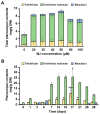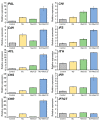The Synergistic Effect of Co-Treatment of Methyl Jasmonate and Cyclodextrins on Pterocarpan Production in Sophora flavescens Cell Cultures
- PMID: 32486319
- PMCID: PMC7313034
- DOI: 10.3390/ijms21113944
The Synergistic Effect of Co-Treatment of Methyl Jasmonate and Cyclodextrins on Pterocarpan Production in Sophora flavescens Cell Cultures
Abstract
Pterocarpans are derivatives of isoflavonoids, found in many species of the family Fabaceae. Sophora flavescens Aiton is a promising traditional Asian medicinal plant. Plant cell suspension cultures represent an excellent source for the production of valuable secondary metabolites. Herein, we found that methyl jasmonate (MJ) elicited the activation of pterocarpan biosynthetic genes in cell suspension cultures of S. flavescens and enhanced the accumulation of pterocarpans, producing mainly trifolirhizin, trifolirhizin malonate, and maackiain. MJ application stimulated the expression of structural genes (PAL, C4H, 4CL, CHS, CHR, CHI, IFS, I3'H, and IFR) of the pterocarpan biosynthetic pathway. In addition, the co-treatment of MJ and methyl-β-cyclodextrin (MeβCD) as a solubilizer exhibited a synergistic effect on the activation of the pterocarpan biosynthetic genes. The maximum level of total pterocarpan production (37.2 mg/g dry weight (DW)) was obtained on day 17 after the application of 50 μM MJ on cells. We also found that the combined treatment of cells for seven days with MJ and MeβCD synergistically induced the pterocarpan production (trifolirhizin, trifolirhizin malonate, and maackiain) in the cells (58 mg/g DW) and culture medium (222.7 mg/L). Noteworthy, the co-treatment only stimulated the elevated extracellular production of maackiain in the culture medium, indicating its extracellular secretion; however, its glycosides (trifolirhizin and trifolirhizin malonate) were not detected in any significant amounts in the culture medium. This work provides new strategies for the pterocarpan production in plant cell suspension cultures, and shows MeβCD to be an effective solubilizer for the extracellular production of maackiain in the cell cultures of S. flavescens.
Keywords: Sophora flavescens; cell cultures; elicitation; maackiain; pterocarpan; trifolirhizin.
Conflict of interest statement
The authors declare no conflict of interest.
Figures






Similar articles
-
Simultaneous determination of trifolirhizin, (-)-maackiain, (-)-sophoranone, and 2-(2,4-dihydroxyphenyl)-5,6-methylenedioxybenzofuran from Sophora tonkinensis in rat plasma by liquid chromatography with tandem mass spectrometry and its application to a pharmacokinetic study.J Sep Sci. 2014 Nov;37(22):3235-44. doi: 10.1002/jssc.201400691. Epub 2014 Sep 30. J Sep Sci. 2014. PMID: 25156071
-
A new pterocarpan, (-)-maackiain sulfate, from the roots of Sophora subprostrata.Arch Pharm Res. 2003 Dec;26(12):1009-13. doi: 10.1007/BF02994750. Arch Pharm Res. 2003. PMID: 14723332
-
Synergistic effect of cyclodextrins and methyl jasmonate on taxane production in Taxus x media cell cultures.Plant Biotechnol J. 2014 Oct;12(8):1075-84. doi: 10.1111/pbi.12214. Epub 2014 Jun 9. Plant Biotechnol J. 2014. PMID: 24909837
-
Methyl Jasmonate Induced Oxidative Stress and Accumulation of Secondary Metabolites in Plant Cell and Organ Cultures.Int J Mol Sci. 2020 Jan 22;21(3):716. doi: 10.3390/ijms21030716. Int J Mol Sci. 2020. PMID: 31979071 Free PMC article. Review.
-
Maackiain: A comprehensive review of its pharmacology, synthesis, pharmacokinetics and toxicity.Chem Biol Interact. 2025 Jan 5;405:111294. doi: 10.1016/j.cbi.2024.111294. Epub 2024 Oct 29. Chem Biol Interact. 2025. PMID: 39477181 Review.
Cited by
-
UV-B Radiation Exhibited Tissue-Specific Regulation of Isoflavone Biosynthesis in Soybean Cell Suspension Cultures.Foods. 2024 Jul 28;13(15):2385. doi: 10.3390/foods13152385. Foods. 2024. PMID: 39123575 Free PMC article.
-
Synergistic Effect of Methyl Jasmonate and Abscisic Acid Co-Treatment on Avenanthramide Production in Germinating Oats.Int J Mol Sci. 2021 Apr 30;22(9):4779. doi: 10.3390/ijms22094779. Int J Mol Sci. 2021. PMID: 33946373 Free PMC article.
References
-
- Yazaki K. Handbook of Plant Biotechnology. Volume 2. Wiley; Chichester, UK: 2004. Natural Products and Metabolites; pp. 811–857.
-
- Croteau R. Natural products (secondary metabolites) In: Buchanan B., Gruissem W., Jones R., editors. Biochemistry and Molecular Biology of Plants. American Society of Plant Physiologists; Rockville, MD, USA: 2002. pp. 1250–1318.
-
- Bae K. In: Medicinal Plants of Korea. Bae K., editor. Kyo-Hak Pub; Seoul, Korea: 2000.
MeSH terms
Substances
Grants and funding
LinkOut - more resources
Full Text Sources
Other Literature Sources

